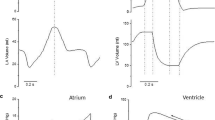Summary
Myosin of the ventricular myocardium of the cardiomyopathic Syrian hamster and of control animals was analysed using non-dissociating pyrophosphate electrophoresis. Three different myosin isoenzymes exhibiting different Ca2+ activated ATPase activities were demonstrated in the ventricular myocardium of the Syrian hamster. As shown by peptide mapping, ventricular myosin isoenzymes differ in their heavy chain composition. In the cardiomyopathic hamster a shift to myosins of lower Ca2+-activated ATPase activities occurs in the stage of insufficiency (age 220 days), whereas no different isoenzyme pattern could be found at the age of 65 days compared to control animals. We conclude that this redistribution of myosin isoenzymes is the basis of reduced myosin ATPase activity in the ventricular myocardium of the cardiomyopathic Syrian hamster during the development of myocardial insufficiency.
Similar content being viewed by others
References
Alpert, N. R., L. A. Mulieri: Heat, mechanics and myosin ATPase in normal and hypertrophied heart muscle. Fed. Proc.41, 192–198 (1982).
Barany, M.: ATPase activity of myosin correlated with speed of muscle shortening. J. Gen. Physiol.50, 197–266 (1967).
Bhan, A., A. Malhotra, V. B. Hatcher, E. H. Sonnenblick, J. Scheuer: Depressed myosin ATPase activity in the hearts of myopathic hamsters. J. Molec. Cell. Cardiol.10, 769–777 (1978).
Ebrecht, G., H. Rupp, R. Jacob: Alterations of mechanical parameters in chemically skinned preparations of rat myocardium as a function of isoenzyme pattern of myosin. Basic Res. Cardiol.77, 220–234 (1982).
Hoh, J. F. Y., P. A. McGrath, R. I. White: Electrophoretic analysis of multiple forms of myosin in fast twitch and slow twitch muscles of the chicken. Biochem. J.157, 87–95 (1976).
Hoh, J. F. Y., P. A. McGrath, P. T. Hale: Electrophoretic analysis of multiple forms of rat cardiac myosin: effects of hypophysectomy and thyroxine replacement. J. Molec. Cell. Cardiol.10, 1035–1076 (1977).
Hoh, J. F. Y., G. P. Yeoh, M. A. Thomas, L. Higginbottom: Structural differences in the heavy chains of rat ventricular myosin isoenzymes. FEBS Letters97, 330–334 (1979).
Lämmli, V. K.: Cleavage of structural proteins during the assembly of the head of the bacteriophage T. Nature227, 680–685 (1970).
Liew, C. C., M. J. Sole: Studies of nuclear proteins in the heart of the cardiomyopathic Syrian hamster-phosphorylation of histones. J. Molec. Cell. Cardiol.10, 847–855 (1978).
Liew, C. C., M. J. Sole: Nuclear proteins in the heart of the cardiomyopathic Syrian hamster. Phosphorylation of phenol soluble non-histone proteins. Circulat. Res.42, 637–643 (1978).
Limas, C. J., C. Limas: Decreased sialyltransferase activity in the hearts of cardiomyopathic Syrian hamsters. Biochim. Biophys. Acta540, 543–546 (1978).
Litten, R. Z., B. J. Martin, R. B. Low, N. R. Alpert: Altered myosin isoenzyme patterns from pressure overloaded and thyrotoxic hypertrophied rabbit hearts. Circulat. Res.50, 856–864 (1982).
Lossnitzer, K.: Genetic induction of a cardiomyopathy. In: Handbook of Experimental Pharmacol. XVI/3, 309–337, Springer-Verlag (Berlin-Heidelberg-New York 1975).
Martin, A. F., E. D. Pagani, R. J. Solaro: Thyroxine induced redistribution of isoenzymes of rabbit ventricular myosin. Circulat. Res.50, 117–124 (1982).
Mercadier, J. J., A. M. Lompre, C. Wisnewsky, J. Samuel, J. Bercovici, B. Swynghedauw, K. Schwartz: Myosin isoenzymic changes in several models of rat cardiac hypertrophy. Circulat. Res.49, 525–532 (1981).
Mohr, W., K. Lossnitzer, J. Schwarz: The cardiomyopathy of the Syrian hamster (strain Bio 8262)-hypertrophic or dystrophic? Basic Res. Cardiol.73, 34–46 (1978).
Proschek, L., G. Jasmin: Hereditary polymyopathy and cardiomyopathy in the Syrian hamster. II. Development of heart necrotic changes in relation to defective mitochondrial function. Muscle and Nerve5, 26–32 (1982).
Rupp, H.: The adaptive changes in the isoenzyme pattern of myosin from hypertrophied rat myocardium as a result of pressure overload and physical training. Basic Res. Cardiol.76, 79–88 (1981).
Sachs, L.: Angewandte Statistik. Springer-Verlag (Berlin-Heidelberg-New York 1974).
Venkatakrishnan, R., A. W. Rourke: The structure, function and turnover of cardiac myosin in normal and myopathic Syrian hamsters. Lab. Investigation41, 198–205 (1979).
Wrogemann, K., E. G. Nylen: Mitochondrial calcium overloading in cardiomyopathic hamsters. J. Molec. Cell. Cardiol.10, 185–195 (1978).
Author information
Authors and Affiliations
Additional information
Supported by the SFB 89, Göttingen
Rights and permissions
About this article
Cite this article
Wiegand, V., Stroh, E., Henniges, A. et al. Altered distribution of myosin isoenzymes in the cardiomyopathic Syrian hamster (BIO 8.262). Basic Res Cardiol 78, 665–670 (1983). https://doi.org/10.1007/BF01907213
Received:
Issue Date:
DOI: https://doi.org/10.1007/BF01907213




